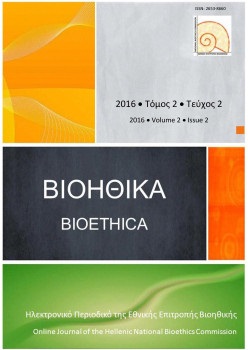Νευροεπιστήμες και ποινικό δίκαιο: υποσχέσεις και περιορισμοί σχετικά με την εκτίμηση της ικανότητας για καταλογισμό
Аннотация
Η ραγδαία εξέλιξη των νευροεπιστημών τα τελευταία χρόνια αποκάλυψε πολλά από τα μυστικά της δομής και της λειτουργίας του εγκεφάλου, φωτίζοντας τις αιτίες της ανθρώπινης συμπεριφοράς. Το Δίκαιο, κανονιστικό μόρφωμα με ρόλο καταλυτικό στη διαμόρφωση της ανθρώπινης συμπεριφοράς, δεν θα μπορούσε να μείνει ανεπηρέαστο.
Τα τελευταία χρόνια, νευροαπεικονιστικές τεχνικές, τόσο ανατομικές όσο και λειτουργικές κάνουν την εμφάνισή τους όλο και πιο συχνά στα Δικαστήρια. Η πρακτική αυτή είναι διαδεδομένη στις Η.Π.Α όπου έχει ήδη συγκροτηθεί σχετική νομολογία, αλλά διεισδύει σταδιακά και στην Ευρώπη. Το αυξανόμενο ενδιαφέρον για τις χρήσεις των νευροεπιστημών στο δίκαιο οδήγησε στη διαμόρφωση ενός νέου κλάδου, του λεγόμενου «Νευροδικαίου». O όρος αυτός περιγράφει το νέο πεδίο επιστημονικής
γνώσης που προκύπτει από τη συνένωση διαφόρων επιστημονικών κλάδων (δικαίου, γνωστικών νευροεπιστημών, νευρολογίας, ψυχιατρικής, φιλοσοφίας, εγκληματολογίας) και που έχει σκοπό να εξετάσει το ρόλο και τις επιπτώσεις της χρησιμοποίησης νευροεπιστημονικών ευρημάτων και τεχνικών στη νομοθεσία αλλά και στη δικαστηριακή πρακτική.
Οι εξελίξεις στον τομέα των γνωστικών νευροεπιστημών προκαλούν το έντονο ενδιαφέρον του νομικού αλλά και του ψυχιατρικού κόσμου και γεννούν ελπίδες για βελτίωση μέσω αυτών της αξιοπιστίας και αντικειμενικότητας των ψυχιατρικών πραγματογνωμοσυνών, περιορίζοντας τις πιθανότητες σφάλματος. Στις ποινικές δίκες, οι τεχνικές αυτές εισάγονται κατά κανόνα από τους συνηγόρους υπεράσπισης με σκοπό την απόδειξη έλλειψης/μειωμένου καταλογισμού των πελατών τους.
H παρούσα δημοσίευση εξετάζει το ζήτημα της χρησιμοποίησης των νευροαπεικονιστικών τεχνικών στις ποινικές δίκες και του βαθμού στον οποίον μπορούν να συμβάλουν στην εκτίμηση του καταλογισμού του κατηγορουμένου. Παρατίθεται μια σύντομη αναδρομή στην ιστορία της σχέσης μεταξύ ποινικού δικαίου και επιστημών του εγκεφάλου, ακολουθεί η παρουσίαση δύο ποινικών υποθέσεων στο πλαίσιο των οποίων χρησιμοποιήθηκαν νευροεπιστημονικές τεχνικές και στη συνέχεια
επισημαίνονται ορισμένοι περιορισμοί και δυσκολίες στη χρησιμοποίηση νευροεπιστημονικών μεθόδων για την εκτίμηση του καταλογισμού, οι οποίες είναι τεχνολογικής, νομικής αλλά και φιλοσοφικής -εννοιολογικής φύσεως.
Οι νευροεπιστημονικές αποδείξεις, όσο κι αν βελτιωθεί η αξιοπιστία τους, δεν αποτελούν παρά μόνο ένα μέρος της συνολικής ψυχιατρικής εκτίμησης, ένα μόνο στοιχείο απόδειξης το οποίο θα πρέπει να λειτουργεί συμπληρωματικά, συνεκτιμώμενο ή και σε αντιπαράθεση με τα υπόλοιπα αποδεικτικά στοιχεία που έχουν συλλεγεί σε διαφορετικά πεδία ανάλυσης, ψυχολογικό, κοινωνιολογικό, οικονομικό κ.ο.κ.
Οι νευροεπιστήμες, ως επιστήμες, μπορούν κατά κανόνα να περιγράψουν λειτουργικά και βιολογικά μοντέλα συμπεριφοράς, ενώ η απόδοση ευθύνης είναι ένα κανονιστικό ζήτημα. Αν και οι νευροεπιστήμες είναι σε ένα βαθμό ικανές να συμβάλουν στην αξιολόγηση της ποινικής ευθύνης εισάγοντας νέες νομοτέλειες στην ανάλυση της συμπεριφοράς των δραστών που πάσχουν από ψυχικές/νευρολογικές διαταραχές, δεν μπορούν να απαλλάξουν από την ανάγκη προσδιορισμού των κριτηρίων απόδοσης ποινικής ευθύνης. Η απόφαση για τα κριτήρια αυτά οφείλει να λαμβάνει υπόψη κοινωνικές, ηθικές και πολιτικές παραμέτρους παραμένει ωστόσο, σε τελική ανάλυση, μια νομική κρίση.
Article Details
- Как цитировать
-
Γκότση (Georgia-Martha Gkotsi) Γ.-Μ. (2016). Νευροεπιστήμες και ποινικό δίκαιο: υποσχέσεις και περιορισμοί σχετικά με την εκτίμηση της ικανότητας για καταλογισμό. Bioethica, 2(2), 19–35. https://doi.org/10.12681/bioeth.19779
- Выпуск
- Том 2 № 2 (2016): Bioethica
- Раздел
- Original Articles
Authors who publish with this journal agree to the following terms:
- Authors retain copyright and grant the journal right of first publication with the work simultaneously licensed under a Creative Commons Attribution CC BY 4.0 License, which allows for immediate free access to the work and permits any user to read, download, copy, distribute, print, search, or link to the full texts of articles, crawl them for indexing, pass them as data to software, or use them for any other lawful purpose. Appropriate credit must be given by citing the author(s) and the original publication in this journal.
- Authors are able to enter into separate, additional contractual arrangements for the non-exclusive distribution of the journal's published version of the work (e.g. post it to an institutional repository or publish it in a book), with an acknowledgement of its initial publication in this journal.
We encourage authors to deposit their articles, as well as data underlying the publications, in institutional and/or other appropriate subject repositories.
Bioethica permits and encourages authors to archive the final publication pdf in institutional (e.g. the repository of the National Hellenic Research Foundation) or other appropriate subject repositories (e.g. SSOAR repository for social sciences), in compliance with institutional and/or funder open access policies, after publication in the BIOETHICA. Authors must provide bibliographic details that credit publication in the journal, as well as related funding details (when applicable).
Lists of institutional and other subject-based academic open access repositories can be found listed by country at the registry http://opendoar.org/countrylist.php
If your institution does not possess a repository you may deposit a copy of your paper at no cost with www.zenodo.org , the repository supported for open access research in the EU by the European Commission, through the project OpenAIRE (www.openaire.eu )



